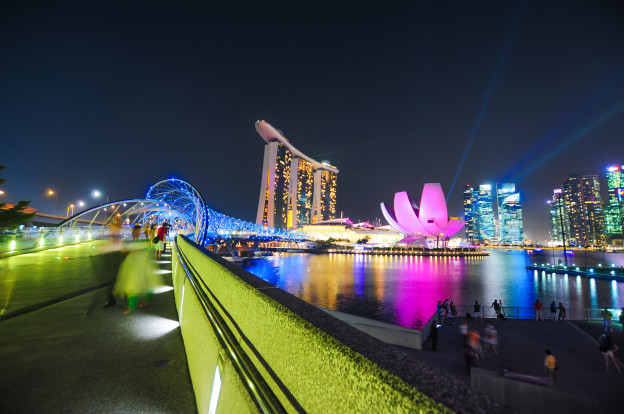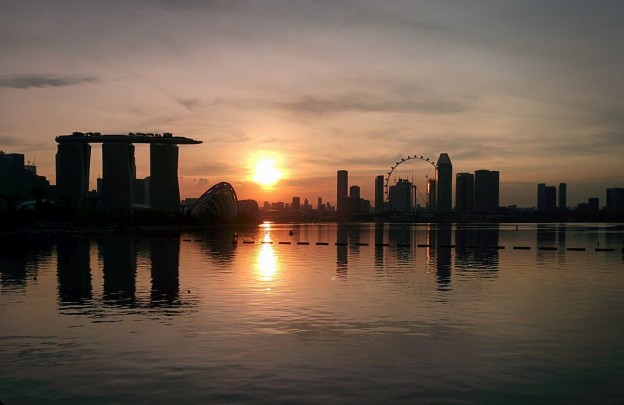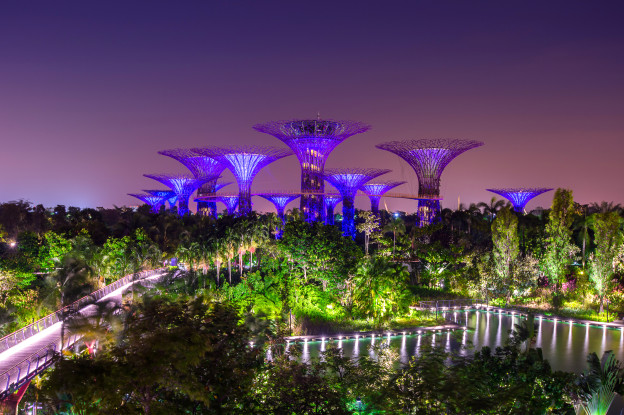Every district and neighbourhood in Singapore has familiar features and aesthetics that blends into an overall uniform look. But, there’s usually just enough to make them distinct on their own.

Whether the buildings are red bricked, multi-coloured, whether there’s a rare Dragon playground languishing nearby; these tell-tale signs add just a bit of spice to denote a uniquely Singaporean look within the greater Asian culture.

Red-bricked HDB flats
Even modern shopping belts like Orchard has a quality that while contemporary, still feels wholly local. One could look at a picture of Orchard Road and point out mainstay locales like Takashimaya and Wheelock as being within Singapore. These things are synonymous with the island and their absence would be felt by generations that had grown up with them in the public consciousness.
But there is one place on the island that has the appearance of something uniquely a-Singaporean; Marina Bay.
Marina Bay was formed out of the sea. In 1969, land reclamation works began with a 30-hectare waterfront site that became the Marina Centre and Marina South areas in 1992. Over the years, it was developed bit by bit into an isle (to maintain its waterfront status) that lent it a look that when compared with the rest of Singapore, is unconventional.
When the Helix bridge was developed to connect Temasek Avenue and the ECP with Bayfront Avenue and Sheares Avenue respectively, people could cross over easily and instantly be greeted by the towering super trees at Gardens by the Bay.

Gardens by the Bay, Singapore
The flower dome and the Singapore Flyer earmark the distant waterfront. Light bounces off the waters of the Marina Bay and the bay acts as if it were a gulf separating two distinct nations. In the horizon, Marina Bay Sands commands the view, complimented only by the abstract design of the ArtScience Museum and backed by the glittering glass skyscrapers of the CBD that curve toward the sky.
The Bay is home to Grade-A office buildings, many of which are connected or in proximity of an extensive underground network linking each disparate location with MRT stations like Bayfront. These underground networks are riddled with underground malls and restaurants. Above ground, busy people flit between office buildings. Those that can afford to stay here do so in posh and luxurious condominiums like One Shenton and Marina One Residences. Gardens by the Bay is almost always packed with families on the weekends and come nightfall when the trees are lit up, the skyline of Marina takes on an ethereal quality.
Marina Bay may not be reminiscent of anything Singaporean but it is quickly becoming the face of a country rapidly moving away from its traditional roots. It is unidentifiable but surprisingly, immediately recognisable in the global market. Its’ unique look has marked it as a popular location to leverage on in the media.
In video game Call of Duty: Black Ops 3, Marina Bay Sands is in a war-torn post-apocalyptic landscape besieged by war. In Hitman, Marina Bay was the site of furious action. In Independence Day: Resurgence, Marina Bay while erroneously assumed to be part of a country that seemed one part Taiwan and one part Hong Kong instead of Singapore, was fabulously destroyed by aliens.
The inherent appeal of Marina Bay is that thematically it is one of the more unique and visually arresting locations worldwide. It looks and feels otherworldly and un-Asian. It is hard to deny its’ appeal; the massive super trees that light up the night sky, Marina Bay Sands’ Stonehenge-like design, the biodome with the indoor waterfall and forest, the ArtScience museum and the omnipresent Singapore Flyer all contribute to a look that is a hodgepodge of landmarks so diverse from everything else available on the island.
Even the Marina Barrage, a new reservoir that prevents the flooding of Chinatown, provides an alternative source of drinking water for Singapore, doubles up as a place of recreation.
The government’s stance regarding Marina Bay is for it to be a prime, waterfront area and it is. Condominiums and mixed residences like One Shenton and Marina One are priced at a median of $1,522 psf. Even offices have a median price of $2,102psf. If you want to live or work in the Manhattan of Singapore, you must pay a premium for it.
New developments are being planned all the time with constant improvements made to the area. Getting to Gardens by the Bay used to be a lesson in tedium but now with the MCE underground highway and the arterial roads of Marina Grove and Marina Gardens Dr, getting in and out is far easier than it was a years ago.
Marina Bay may not look Singaporean but that’s hardly a bad thing. It gives the island an extra edge to differentiate itself from the rest of its Asian counterparts while providing a new landmark outside of the Merlion, for a different generation of globetrotters to associate Singapore with. It marches along with the changing face of Singaporeans and may in time, come to represent a new status quo.
In 10 years, Marina Bay will change once again and in a hundred years, what it will look like to a newer, more enlightened society is a new Singapore worth working towards.




